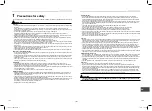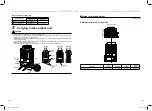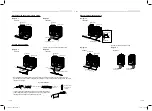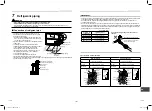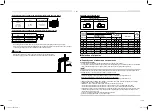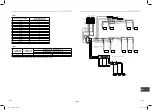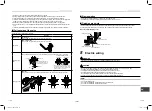
– 2 –
4-EN
3-EN
EN
FR
1
Precautions for safety
The manufacturer shall not assume any liability for the damage caused by not observing the description of this manual.
WARNING
General
• Carefully read Owner’s Manual before starting the air conditioner. There are many important things to keep in mind for daily
operation.
• Ask for installation to be performed by the dealer or a professional. Only a quali
fi
ed installer is able to install an air
conditioner. If a non-quali
fi
ed person installs an air conditioner, it may result in problems such as
fi
re, electric shock, injury,
water leakage, noise and vibration.
• Do not use any refrigerant different from the one speci
fi
ed for complement or replacement.
Otherwise, abnormally high pressure may be generated in the refrigeration cycle, which may result in a failure or
explosion of the product or an injury to your body.
• Before opening the service panel of the outdoor unit, set the circuit breaker to the OFF position. Failure to set the circuit
breaker to the OFF position may result in electric shocks through contact with the interior parts.
• Before carrying out the installation, maintenance, repair or removal work, be sure to set the circuit breakers for both the
indoor and outdoor units to the OFF position. Otherwise, electric shock may result.
• Wear protective gloves and safety work clothing during installation, servicing and removal.
• Do not touch the aluminium
fi
n of the outdoor unit. You may injure yourself if you do so. If the
fi
n must be touched for some
reason,
fi
rst put on protective gloves and safety work clothing, and then proceed.
• Do not climb onto or place objects on top of the outdoor unit. You may fall or the objects may fall off of the outdoor unit and
result in injury.
• Before cleaning the
fi
lter or other parts of the outdoor unit, set the circuit breaker to OFF without fail, and place a “Work in
progress” sign near the circuit breaker before proceeding with the work.
• The refrigerant used by this air conditioner is the R410A.
• The air conditioner must be transported in stable condition. If any part of the product are broken, contact your distributor.
Selection of installation location
• Do not install in a location where
fl
ammable gas leaks are possible. If the gas should leak and accumulate around the unit,
it may ignite and cause a
fi
re.
• During transporting the air conditioner, wear shoes with protective toe caps, protective gloves, and other protective clothing.
• To transport the air conditioner, do not take hold of the bands around the packing carton. You may injure yourself if the
bands should break.
• Places where the operation sound of the outdoor unit may cause a disturbance. (Especially at the boundary line with
a neighbour, install the air conditioner while considering the noise.)
Installation
• The designated bolts (M12) and nuts (M12) for securing the outdoor unit must be used when installing the unit.
• Install the outdoor unit property in a location that is durable enough to support the weight of the outdoor unit. Insuf
fi
cient
durability may cause the outdoor unit to fall, which may result in injury.
• Install the unit in the prescribed manner for protection against strong wind and earthquake. Incorrect installation may result
in the unit falling down, or other accidents.
• Fix the screws back which have been removed for installation or other purposes.
Refrigerant piping
• Install the refrigerant pipe securely during the installation work before operating the air conditioner. If the compressor is
operated with the valve open and without refrigerant pipe, the compressor sucks air and the refrigeration cycles is over
pressurized, which may cause a injury.
• Tighten the
fl
are nut with a torque wrench in the speci
fi
ed manner. Excessive tighten of the
fl
are nut may cause a crack in
the
fl
are nut after a long period, which may result in refrigerant leakage.
• When the air conditioner has been installed or relocated, follow the instructions in the Installation Manual and purge the air
completely so that no gases other than the refrigerant will be mixed in the refrigerating cycle. Failure to purge the air
completely may cause the air conditioner to malfunction.
• Nitrogen gas must be used for the airtight test.
Electrical wiring
• Only a certi
fi
ed installer or quali
fi
ed service person is allowed to carry out the electrical work of the air conditioner.
• When connecting the electrical wires, repairing the electrical parts or undertaking other electrical jobs, wear gloves to
provide protection for electricians and from heat, insulating shoes and clothing to provide protection from electric shocks.
Failure to wear this protective gear may result in electric shocks.
• When executing address setting, test run, or troubleshooting through the checking window on the electric parts box, put on
insulated heat-proof gloves, insulated shoes and other clothing to provide protection from electric shock. Otherwise you
may receive an electric shock.
• Use wiring that meets the speci
fi
cations in the Installation Manual, NEC and the local codes.
• Check that the product is properly grounded.
• Do not connect the ground line to a gas pipe, water pipe, lightning conductor, or a telephone ground line.
• After completing the repair or relocation work, check that the ground wires are connected properly.
• Install a circuit breaker that meets the speci
fi
cations in the installation manual, NEC and local codes.
• Under no circumstances must the power cable be extended. Connection trouble in the places where the cable is extended
may give rise to smoking and/or a
fi
re.
• Do not supply power from the power terminal block equipped on the outdoor unit to another outdoor unit. Capacity over
fl
ow
may occur on the terminal block and may result in
fi
re.
• Each outdoor unit should have its own power supply.
Test run
• Before operating the air conditioner after having completed the work, check that the electrical parts box cover of the indoor
unit and service panel of the outdoor unit are closed, and set the circuit breaker to the ON position. You may receive an
electric shock if the power is turned on without
fi
rst conducting these checks.
• If there is any kind of trouble (such as when a check code display has appeared, there is a smell of burning, abnormal
sounds are heard, the air conditioner fails to cool or heat or water is leaking) has occurred in the air conditioner, do not
touch the air conditioner yourself but set the circuit breaker to the OFF position, and contact a quali
fi
ed service person.
Take steps to ensure that the power will not be turned on (by marking “out of service” near the circuit breaker, for instance)
until quali
fi
ed service person arrives. Continuing to use the air conditioner in the trouble status may cause mechanical
problems to escalate or result in electric shocks or other failure.
• Upon completion of the installation work, check for refrigerant leaks and check the insulation resistance and water drainage.
Then conduct a test run to check that the air conditioner is operating properly.
Explanations given to user
• Upon completion of the installation work, tell the user where the circuit breaker is located. If the user does not know where
the circuit breaker is, he or she will not be able to turn it off in the event that trouble has occurred in the air conditioner.
• If the fan grille is damaged, do not approach the outdoor unit but set the circuit breaker to the OFF position, and contact a
quali
fi
ed service person to have the repairs done. Do not set the circuit breaker to the ON position until the repairs are
completed.
• After the installation work, follow the Owner’s Manual to explain to the customer how to use and maintain the unit.
Relocation
• Only a certi
fi
ed installer or service person is allowed to relocate the air conditioner.
• When the pump-down work is carried out shut down the compressor before disconnecting the refrigerant pipe.
Disconnecting the refrigerant pipe with the service valve left open and the compressor still operating will cause air or other
gas to be sucked in, raising the pressure inside the refrigeration cycle to an abnormally high level, and possibly resulting
in rupture, injury or other trouble.
•
Do not recover the refrigerant into the outdoor unit. Use a refrigerant recovery machine to recover the refrigerant after
moving or repairing. It is impossible to recover the refrigerant into the outdoor unit. Refrigerant recovery into the outdoor
unit may result in serious accidents such as explosion of the unit, injury or other accidents.
CAUTION
•
THIS AIR CONDITIONER USES THE ENVIRONMENTALLY FRIENDLY HFC REFRIGERANT (R410A) WHICH DOES
NOT DESTROY OZONE LAYER.
1122001201_EN FR.indd 2
1122001201_EN FR.indd 2
9/2/16 1:30 PM
9/2/16 1:30 PM



